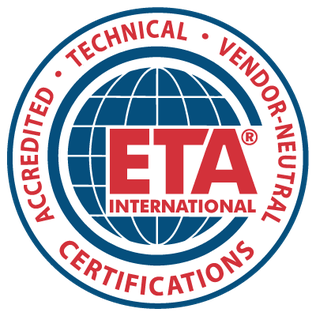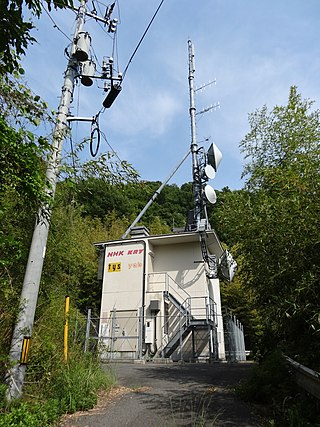
Morse code is a method used in telecommunication to encode text characters as standardized sequences of two different signal durations, called dots and dashes, or dits and dahs. Morse code is named after Samuel Morse, one of the early developers of the system adopted for electrical telegraphy.

Wireless telegraphy or radiotelegraphy is transmission of text messages by radio waves, analogous to electrical telegraphy using cables. Before about 1910, the term wireless telegraphy was also used for other experimental technologies for transmitting telegraph signals without wires. In radiotelegraphy, information is transmitted by pulses of radio waves of two different lengths called "dots" and "dashes", which spell out text messages, usually in Morse code. In a manual system, the sending operator taps on a switch called a telegraph key which turns the transmitter on and off, producing the pulses of radio waves. At the receiver the pulses are audible in the receiver's speaker as beeps, which are translated back to text by an operator who knows Morse code.

AM broadcasting is radio broadcasting using amplitude modulation (AM) transmissions. It was the first method developed for making audio radio transmissions, and is still used worldwide, primarily for medium wave transmissions, but also on the longwave and shortwave radio bands.

A radiotelephone, abbreviated RT, is a radio communication system for conducting a conversation; radiotelephony means telephony by radio. It is in contrast to radiotelegraphy, which is radio transmission of telegrams (messages), or television, transmission of moving pictures and sound. The term is related to radio broadcasting, which transmit audio one way to listeners. Radiotelephony refers specifically to two-way radio systems for bidirectional person-to-person voice communication between separated users, such as CB radio or marine radio. In spite of the name, radiotelephony systems are not necessarily connected to or have anything to do with the telephone network, and in some radio services, including GMRS, interconnection is prohibited.

Low-power broadcasting is broadcasting by a broadcast station at a low transmitter power output to a smaller service area than "full power" stations within the same region. It is often distinguished from "micropower broadcasting" and broadcast translators. LPAM, LPFM and LPTV are in various levels of use across the world, varying widely based on the laws and their enforcement.

WHA is a non-commercial radio station, licensed since 1922 to the University of Wisconsin and located in Madison, Wisconsin. It serves as the flagship for the Wisconsin Public Radio talk-based "Ideas Network". WHA's programming is also broadcast by two low-powered FM translators, and by WERN FM's HD3 digital subchannel. The station airs a schedule of news and talk programs from Wisconsin Public Radio, NPR, American Public Media, Public Radio International, the Canadian Broadcasting Corporation and the BBC.

Marine VHF radio is a worldwide system of two way radio transceivers on ships and watercraft used for bidirectional voice communication from ship-to-ship, ship-to-shore, and in certain circumstances ship-to-aircraft. It uses FM channels in the very high frequency (VHF) radio band in the frequency range between 156 and 174 MHz, designated by the International Telecommunication Union as the VHF maritime mobile band. In some countries additional channels are used, such as the L and F channels for leisure and fishing vessels in the Nordic countries. Transmitter power is limited to 25 watts, giving them a range of about 100 kilometres.
The Global Maritime Distress and Safety System (GMDSS) is a worldwide system for automated emergency signal communication for ships at sea developed by the United Nations' International Maritime Organization (IMO) as part of the SOLAS Convention.

KUOM – branded Radio K – is a daytime-only, non-commercial, college radio station licensed to Minneapolis, Minnesota. Owned by the University of Minnesota, Twin Cities, the station is operated by students and faculty. It mainly airs alternative rock with other genres of music. The studios are in Rarig Center on the University of Minnesota campus.
From early in the 20th century, the radio frequency of 500 kilohertz (500 kHz) was an international calling and distress frequency for Morse code maritime communication. For much of its early history, this frequency was referred to by its equivalent wavelength, 600 meters, or, using the earlier frequency unit name, 500 kilocycles or 500 kc.
The Radio Act of 1912, formally known as "An Act to Regulate Radio Communication", is a United States federal law which was the country's first legislation to require licenses for radio stations. It was enacted before the introduction of broadcasting to the general public, and was eventually found to contain insufficient authority to effectively control this new service, so the Act was replaced and the government's regulatory powers increased by the passage of the Radio Act of 1927.
A broadcast license is a type of spectrum license granting the licensee permission to use a portion of the radio frequency spectrum in a given geographical area for broadcasting purposes. The licenses generally include restrictions, which vary from band to band.
In broadcasting and radio communications, a call sign is a unique identifier for a transmitter station. A call sign can be formally assigned by a government agency, informally adopted by individuals or organizations, or even cryptographically encoded to disguise a station's identity.

In the United States, amateur radio licensing is governed by the Federal Communications Commission (FCC). Licenses to operate amateur stations for personal use are granted to individuals of any age once they demonstrate an understanding of both pertinent FCC regulations and knowledge of radio station operation and safety considerations. Applicants as young as five years old have passed examinations and were granted licenses.

The Electronics Technicians Association, International, Inc. is a US-based not-for-profit 501(c)(6) trade association founded in 1978. The association provides certifications in industries such as basic electronics, fiber optics and data cabling, renewable energy, information technology, photonics and precision optics, customer service, biomedical, avionics, wireless communications, radar, and smart home. ETA is also one of the 12 COLEMs for U.S. Federal Communications Commission (FCC) testing. ETA works with technicians, educators, and military personnel. ETA also partners with companies such as Motorola Solutions to provide certification to their employees.
The Wireless Ship Act of 1910, formally titled "An Act to require apparatus and operators for radio-communication on certain ocean steamers" and also known as the "Radio Ship Act of 1910" and the "Radio Act of 1910", was the first federal legislation regulating radio communication in the United States. It required certain ocean-going vessels exiting U.S. ports to carry radio equipment, and although it did not require stations or operators to be licensed, it did require certification that operators and radio equipment met minimum standards.

A broadcast relay station, also known as a satellite station, relay transmitter, broadcast translator (U.S.), re-broadcaster (Canada), repeater or complementary station (Mexico), is a broadcast transmitter which repeats the signal of a radio or television station to an area not covered by the originating station.

A Yachtmaster qualification is a certificate of competence of the ability to handle either a sailing boat or motor boat in certain prescribed conditions. Three different titles are specified; Yachtmaster Coastal, Yachtmaster Offshore, and Yachtmaster Ocean which specify the level of competence required and the area of operation certified.

Amateur radio, also known as ham radio, is the use of the radio frequency spectrum for purposes of non-commercial exchange of messages, wireless experimentation, self-training, private recreation, radiosport, contesting, and emergency communications. The term "amateur" is used to specify "a duly authorized person interested in radioelectric practice with a purely personal aim and without pecuniary interest"; and to differentiate it from commercial broadcasting, public safety, or professional two-way radio services.
Certified Radio Operator (CRO) is a title granted to an individual in the United States who passes the examination requirements of the certification. The certification is regulated by the Society of Broadcast Engineers. The CRO title is protected by copyright laws.













